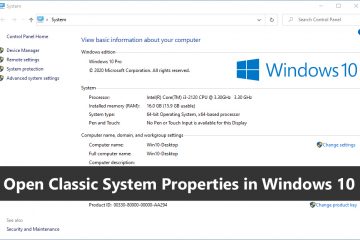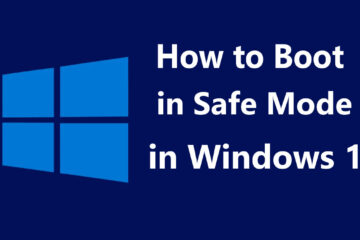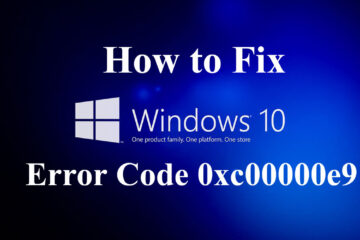If your Windows 10 screen is constantly flickering, it is probably because you have installed a problematic app or the wrong display driver. It’s time for you to solve this annoying screen flash.

The problem often starts when you upgrade to Windows 10 from a previous version of the operating system, but it can happen at any time. We are going to show you different methods to fix Windows 10 flashing screen.
How to Fix Screen Flickering and Flashing on Windows 10
First, you need to determine the cause of the screen flicker. To do this, open Task Manager by simultaneously pressing Ctrl + Shift + Esc.
Otherwise, right-click on your taskbar and choose Task Manager. You don’t need to use Task Manager, but you do have to open it.
Now check on your screen if Task Manager is flashing. If so, then as with everything else on the screen, the problem is most likely caused by your hardware or a faulty display driver. On the other hand, if everything is flashing except Task Manager, then the problem is most likely with one application.
If it’s the first, follow the instructions below in order. If it’s the latter, go to step five. That said, if the tips don’t work, check out the tips in the other sections as well.
1. Check Your Monitor and Cable
If you have a flashing screen, the first thing to do is to rule out hardware. Check all cable connections between the monitor and the computer, remove and reconnect them to make sure the cables are secure.
If you have a spare monitor cable, try using that instead. Or buy a replacement online as it is an inexpensive purchase. Cables may wear out over time, or they may have been secretly chewed on by a pet. Either way, replace the cable and see if it stops the screen flickering.
If you can, try a different monitor. If this fixes the problem, then you know the problem is your monitor. At this point, contact the manufacturer for assistance or to make a warranty claim.
2. Set the Correct Refresh Rate
A monitor’s refresh rate is the speed at which the screen updates frames per second, measured in hertz (Hz). Basic monitors can typically only handle a 60Hz refresh rate, while more advanced monitors, typically aimed at gamers, can reach up to 360Hz.
It is important that you set the appropriate refresh rate for your monitor. Sometimes a monitor manufacturer supports an overclocked refresh rate, but this can cause the screen to flicker.
To adjust your refresh rate:
- Press Windows Key + I to open Settings.
- Click on System.
- Click on Advanced Display Settings.
- Use the refresh rate drop-down list and select gradually lower rates until the screen stops flashing. If the blinking continues, return to your monitor’s recommended refresh rate.
3. Reset Your Display Driver
A flickering screen can be caused by your display driver. You may have an old driver or a faulty new one. Let’s make sure you are running the correct version for your system.
Remove Driver
- Press Windows Key + I to open Settings.
- Select Update & Security > Recovery.
- Under Advanced Startup, click Restart Now.
- When your system restarts, select Troubleshoot > Advanced Options > Startup Settings > Restart.
- Again, once restarted, select option five to launch your PC in Safe Mode with Networking.
Then use Device Manager to uninstall the display driver:
- Press Windows Key + X and click Device Manager.
- Double-click the graphics card to expand the category.
- Right-click your graphics card, click Uninstall device, check to Remove driver software for this device, and then click OK.
- Restart your system again.
Alternatively, you can use third-party display driver uninstaller software, which will completely erase all traces of the driver from your system.
Install a new driver
Now you want to install the latest drivers for your system. Windows Update will provide the driver it thinks is compatible with your system. To do this:
- Press Windows Key + I to open Settings.
- Click Update & Security.
- Click on Check for Updates.
You can also go to your graphics card manufacturer’s website (probably AMD or Nvidia) and download the drivers manually from there.
Download the driver, install it, and see if the screen flickering problem stops.
Roll Back to an Older Driver
If the problem persists, the latest driver may not have resolved the problem. If the screen flickers after updating the driver, try reverting to an older version.
Follow the steps above to uninstall the driver, then visit the older drivers page for AMD, NVIDIA, or Intel. It may take a little trial and error, but when your screen isn’t flickering, try selecting the one that’s issued.
4. Reinstall Your Graphics Card
If the problem isn’t with your display driver, it doesn’t necessarily mean that your graphics card isn’t to blame. If your graphics card is not properly seated in your motherboard, this can cause the screen to flicker.
You can easily check this if your motherboard has integrated graphics. Remove the monitor cable from your graphics card and plug it into the display slot on the motherboard instead. If the blinking stops, you know that the graphics card is the problem.
Shut down your PC, unplug everything, open the case, and remove your graphics card from the motherboard. Then carefully reinstall it, making sure the card is firmly inserted into the logic board.
Of course, if you’re feeling uncomfortable working inside a computer, don’t do it, as you could make matters worse.
If this does not solve the problem, your graphics card may be faulty. Contact the manufacturer for assistance or to claim a warranty.
5. Uninstall Problematic Apps
Some apps are incompatible with Windows 10 and can cause the screen to flicker. Ask yourself if you installed any new software or if an app was recently updated before the screen blinked. In the past, the three problematic apps were Norton Antivirus, iCloud, and IDT Audio.
On all your apps, make sure you’re running the latest version. Update in the app itself or visit the respective official websites and download the latest version. You can also check out the developer’s help page for recently updated apps to see if screen flickering has been known to be a recent bug.
If that doesn’t work, uninstall the program. do this:
- Press Windows Key + I to open Settings.
- Click on Application.
- Click Sort by and choose Installation date.
- Click on the offending application and click on Uninstall. You may need to restart your system for the changes to take effect in full.
6. Create a New Windows User Profile
Many Windows 10 issues can often be resolved by creating a new user profile. Screen flickering is one of them.
To create a new account:
- Press Windows Key + I to open Settings.
- Go to Accounts > Family & Other Users.
- Click Add someone else to this PC and follow the wizard.
For tips on moving your files, check out our guide on troubleshooting problems with a new user account.
Conclusion
As with most Windows 10 issues, no single fix will work for everyone. Hopefully one of the above steps has fixed your Windows 10 screen flickering problem.
If it’s time for a new monitor, you can do a lot of productive and fun things with the old one. If not, take it out for recycling so it can rest in the monitor haven.



0 Comments